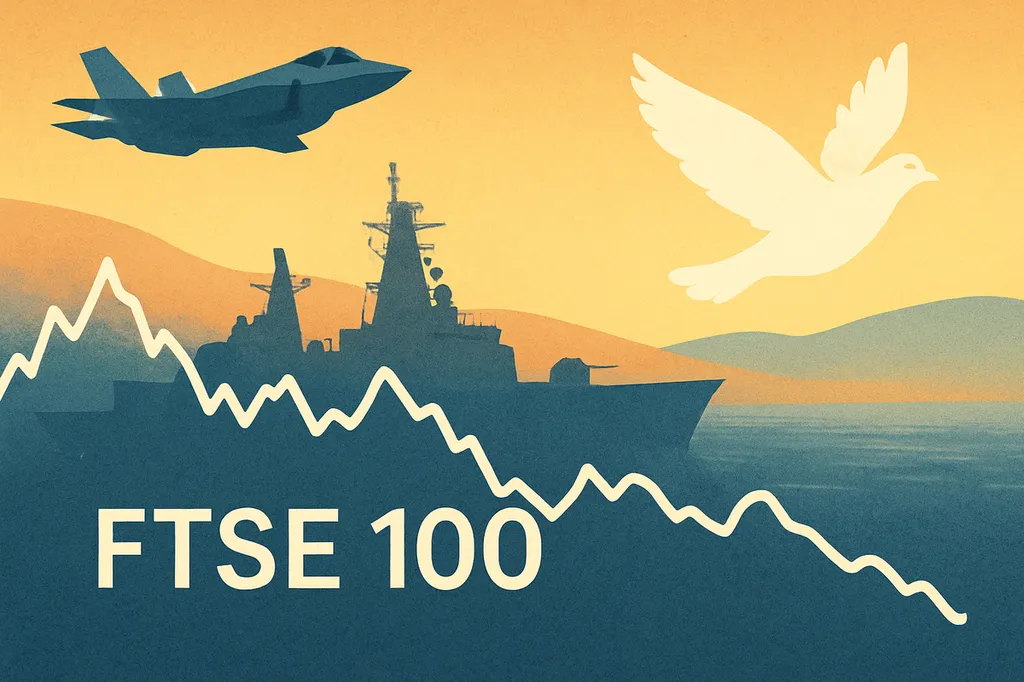The FTSE 100’s recent downturn, driven by a sharp decline in defense stocks, has sent a clear signal: the market is recalibrating its risk assessment in response to evolving geopolitical dynamics. The catalyst? A glimmer of hope in the Middle East, where a tentative peace initiative has sparked a wave of profit-taking in the defense sector. This shift is not just a market correction—it’s a reflection of a broader strategic realignment, one that could reshape the defense industry’s trajectory in the years ahead.
On October 9, 2025, the FTSE 100 dropped 39.47 points, a 0.4% decline, closing at 9,509.40. The slide continued into the following week, with defense stocks bearing the brunt of the sell-off. BAE Systems, the UK’s largest defense contractor, saw its shares dip 0.5% on October 9 and 1.2% by October 13. Babcock International Group, another key player, experienced a 1.1% drop on October 9 and a steeper 2.5% decline by October 13. The trend extended to aerospace and defense-related firms like QinetiQ, Melrose Industries, and Rolls-Royce Holdings, all of which saw notable declines.
The market’s reaction was swift and decisive. Investors, who had long bet on sustained geopolitical instability as a driver of defense sector growth, are now recalibrating their portfolios. The Israel-Hamas ceasefire agreement, with its promise of de-escalation, has triggered a “risk-premium release value,” prompting a re-evaluation of defense stocks that had thrived on prolonged conflict. The broader Stoxx Europe Aerospace and Defense Index mirrored this sentiment, with European defense giants like Hensoldt and Renk also experiencing downward pressure.
This shift is not merely a temporary blip. It underscores a fundamental truth: defense stocks are highly sensitive to geopolitical winds. The war in Ukraine had fueled a surge in defense spending, driving strong performance in the sector. But the Middle East peace deal has introduced a new variable—one that challenges the assumption of perpetual conflict-driven growth. Analysts suggest that while this correction may be sentiment-driven in the short term, long-term drivers, such as NATO’s higher spending targets and the need to replenish depleted stockpiles, will likely sustain demand. However, the immediate impact is undeniable: defense firms are facing a period of uncertainty, forcing them to adapt or risk falling behind.
For companies like BAE Systems, the challenge is clear. With a core business built on military aircraft, ships, and defense systems, BAE is particularly vulnerable to shifts in government spending. A sustained period of peace could threaten its order books, prompting a strategic pivot toward diversification. Rolls-Royce, while more diversified, still relies on defense contracts for a significant portion of its revenue. The company may need to accelerate its shift toward civilian aerospace and sustainable technologies to offset potential losses in the defense sector.
Babcock International Group, a key provider of engineering services for defense, could see fewer contracts if military operations scale back. QinetiQ, focused on defense research and development, might face reprioritization of R&D budgets, though its expertise in cybersecurity could offer some resilience. These companies are now at a crossroads: adapt or risk being left behind.
Meanwhile, other sectors stand to gain from the potential “peace dividend.” Tourism and hospitality, for instance, could see a surge in demand as international travel becomes safer and more affordable. Airlines like easyJet and International Consolidated Airlines Group (IAG) could benefit from renewed consumer confidence and lower fuel costs. Energy and infrastructure sectors may also see opportunities, particularly in post-conflict reconstruction efforts. Financial services companies with emerging market exposure, such as HSBC and Standard Chartered, could see increased investor confidence and foreign direct investment. Consumer goods and retail firms may also benefit from improved economic sentiment and lower energy costs.
The broader implications of this shift are profound. The defense industry, which has enjoyed sustained growth due to escalating global tensions, may now face a period of strategic re-evaluation. While the global defense market is still projected to grow, driven by modernization efforts and technological advancements, the immediate urgency for conventional weaponry may diminish. This could compel major defense contractors to intensify their focus on dual-use technologies or diversify into civilian aerospace, cybersecurity, and advanced engineering solutions.
In the end, this market correction is more than just a reaction to a single geopolitical event. It’s a reminder that the defense sector, like all industries, is subject to the ebb and flow of global dynamics. As the world navigates a potential shift toward peace, the defense industry must adapt

